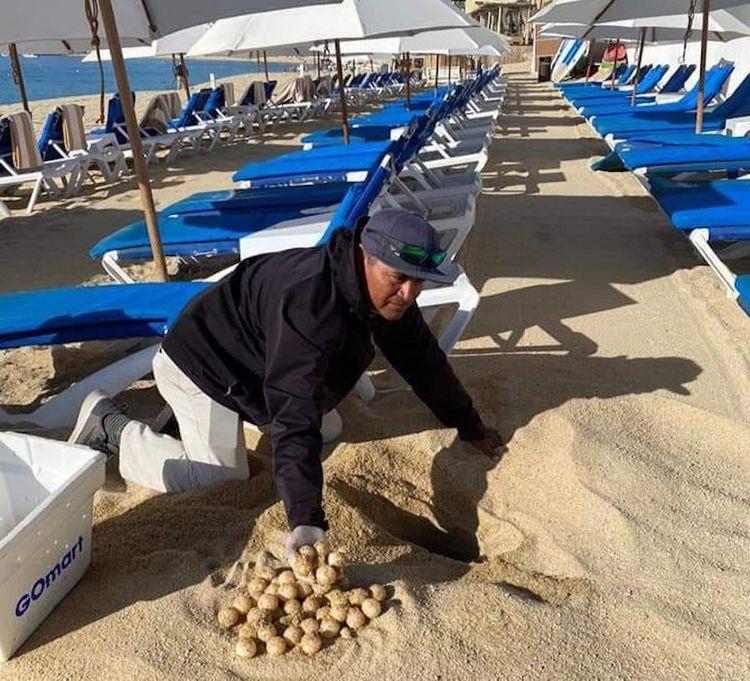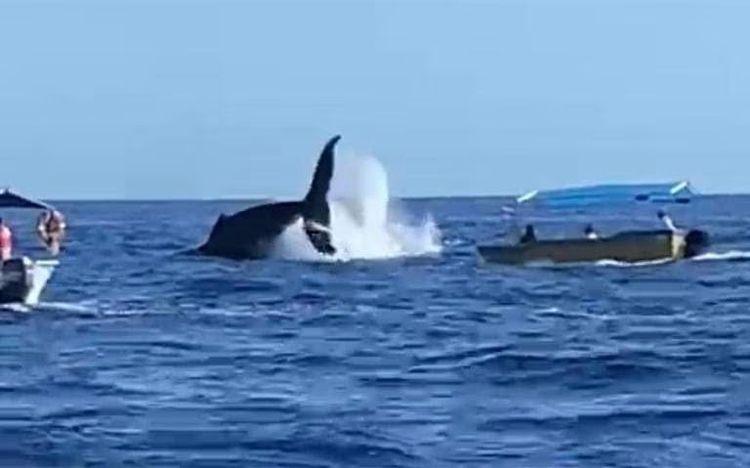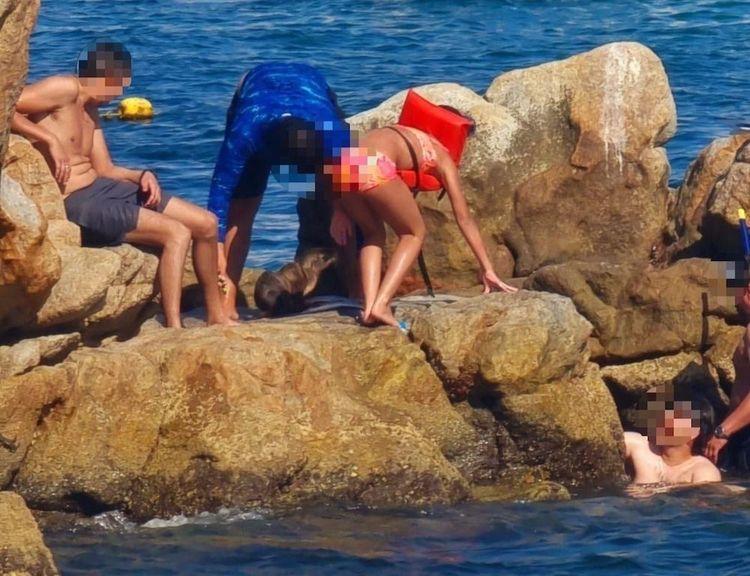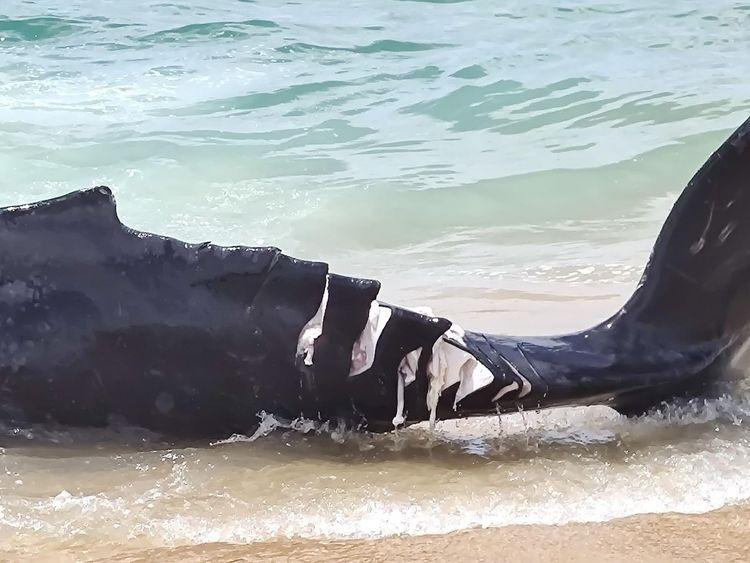Spawning of sea turtles between loungers and umbrellas, sea lions displaced from their habitat and whales injured by boat propels are part of the landscape that has been created in the Bay of Cabo San Lucas as a result of the tourist boom in Los Cabos.
The pressure exerted by tourist activities, especially in the area of El Médano beach, the main beach in Cabo San Lucas, has caused side effects on turtles, said biologist Graciela Tiburcio, a specialist in Wildlife Management and Conservation.
Among these, the co-founder of the Network for the Protection of Sea Turtles highlighted: the impact of their life cycle, loss of their habitat due to hotel construction, obstruction of nesting areas, light pollution and propelasation (propeller stroke) due to excessive boat traffic.
The fact is that the tourism industry of Los Cabos has “appropriated” El Médano with the installation of loungers, umbrellas and even some fences to delimit the area of Beach Clubs, which has caused the Federal Maritime Terrestrial Zone, a strip of 20 meters away that must be of “free, passable land adjacent to the beach” in accordance with the law.
El Médano is considered a nesting beach for sea turtles, 1,033 turtle nests were protected during 2022 and 91,140 young were released, according to data from the Hotel Hacienda.
The Golfina is one of the species that spawn several times throughout the year, although its nesting season is from July to November.
Thus, the current situation of El Médano contrasts with what is established by the Official Mexican Standard NOM-162- SEMARNAT-2012 in its article 5.4.3, which states that during the nesting season for sea turtles “any movable object that has the capacity to trap, entangle or prevent the passage of nesting turtles and their young must be removed”.

Omar Legaria of the Sea Turtle Protection Network guarding 80 eggs. Photo: Omar Legaria.
“El Médano is being lost, but not only because of invasion, two things are combined: the human voracity to have possession of those areas that are attractive and climate change. With this, not only do turtles lose, but also the species that live on the beach that are part of the ecosystem,” said the biologist.
“The beach is collapsed and you can't walk, the authority's answer is that they have an authorization, but why do they give them that authorization if they are nesting areas for sea turtles, the law is very clear,” he added.
Hearing pollution
Turtles aren't the only species that are collaterally affected by tourist activities in Cabo San Lucas Bay. Noise pollution is a barely perceptible “enemy” for humans that seriously affects whales and their young during the sighting season, which starts from December 15 to April 15 in Los Cabos, explained the tour guide for NOM 08, a diver and member of the National Network for Assistance to Enmeshed Whales (RABEN), Oscar Ortiz.
The expert explained that, although it seems that the main impact on whales (especially the Humpback, which is the species that reaches Cabo San Lucas) is meshing with nets, the noise caused by boats that “chase” whales for sighting is so loud that it can be exemplified as if a person were entering a room with a thousand blenders turned on.
Although the NOM-131-SEMARNAT-2010 states that there should be no more than 4 boats at a certain distance and of a certain size carrying out observation activities, Ortiz says he has seen up to 20 boats chasing a mother and her calf.

More than 3 boats a few meters away from a whale in Cabo San Lucas. Photo: Provided anonymously.
“The sound under the sea is 7 times louder than that of the surface, the noise is affecting a lot inside the bay because more and more people are engaged in whale watching and not all of them have a professional ethic of good practices. Whales use echolocation and harassing them with so much noise makes them lose strength and more so because they don't feed here, they just come to give birth,” he said.
The lack of vigilance on the part of the authority, in this case the Federal Attorney for Environmental Protection (Profepa), said Ortiz, has been a facilitator for those who have bad practices to continue to do so without any sanction.
Currently, Los Cabos has only two people (from Profepa) who are responsible for monitoring the entire maritime land area of the municipality, and they don't even have the necessary tools to carry out their work, such as having a boat.
From 2019 to 2022, the General Directorate of Wildlife of the Secretariat of Environment and Natural Resources (Semarnat) went from granting 80 to 300 permits for boats to provide whale watching services in Cabo San Lucas Bay, which exemplifies the demand for this tourist activity.
However, in the last season there was not even a maximum number of permits, “whoever asked for it, they granted it,” explained the director of the Cabo San Lucas Flora and Fauna Protection Area (APFF) of the National Commission for Protected Natural Areas (Conanp), Maria Josue Navarro.
Despite the fact that Conanp witnesses the malpractices carried out by tourism service providers, Navarro pointed out that they do not have the power to monitor and punish those who do not comply with the rules, but are only an “adjuvant” authority that reports on what is happening and then make a complaint and have Profepa heed and sanction the action.
Boat crashes
Boat crashes are other effects that whales face as a result of the high speed with which they travel through Cabo San Lucas Bay.
For Ortiz, the topic hasn't been talked about enough. Consider that we think about the short-term economic impact of nautical tourism over the welfare of the specimens.
On the other hand, proof that species such as the Sea Lion have been affected by tourists in Cabo San Lucas Bay is the unusual birth of a baby in the Pelican stone, on the side of the Arc, which was harassed numerous times by people who got out of boats and climbed the rock to take pictures and feed it.

Baby sea lion being harassed by tourists in Cabo San Lucas. Credits: APFF.
Fernando Elorriaga, a doctor who is a member of the Baja California Sur State Network for Strandling of Marine Mammals and a researcher of pinnipeds (sea lions and seals), explained that harassment of species is the main problem that causes tourism in Cabo San Lucas Bay to this species and is observed in the feeding of specimens despite being illegal and harassment due to invasion of their habitat.
Although the birth of the calf is an unusual case, he noted that out of “common sense” visitors should refrain from wanting to touch or feed sea lions.
In the Gulf of California there are thirteen breeding colonies of this species, the Cabo San Lucas area is only a rest area because it does not have the necessary characteristics for the birth of young, such as the availability of food in the area.
“This breeding alone has had a worrying number of cases of harassment and it seems that this is encouraged by tourist service providers who want extra tips, tourism is not bad and an example of this is the management of tourism on Espíritu Santo Island, that islet is one of the largest colonies in the Gulf of California and the most visited of BCS, visitors are respectful unlike those who visit Cabo San Lucas where this awareness of the species is lacking in tourists,” said the researcher.
Following the problem of harassment of sea lions, Elorriaga warned that it could lead to an alteration in the behavior of the species, as has happened with the issue of feeding, or that its colony moves from place to place.
However, to avoid these extremes, the researcher believes that there can be a balance between tourism, which is the main economic source of cattle, and good management of the bay; above all, raising awareness among visitors because at present, the authority is doing what it can with the resources it has.
Boats and more boats
El Médano is only part of the impacts on Cabo San Lucas Bay and the species that inhabit it. The daily traffic of boats providing tourist services, departing from La Marina to the Arco de Cabo San Lucas and its surroundings, has generated concern even in the sector itself about the lack of control and poor surveillance that lead to abuses of marine species.
Although, the requirements of the Port Authority are clear about the permits that a vessel must have to operate and the criteria for not giving nautical tourism permits if there is no physical space for the boat to spend the night, there are people inside La Marina who have “lent themselves” to giving letters to indicate that they have a pier, revealed the president of the Association of Nautical Tourism Entrepreneurs, Jose Manuel Ochoa.
“If they need to provide a service, they come, they pay a person, people go on the tour and return, which speaks to us of a saturation, of a reality that those boats should not be here and that things are not being done correctly, I presume that they are deceiving the authority and that causes an overtraffic, the heavy traffic that we have with those who are legally registered,” he said.
On a tour that took place through La Marina and El Médano beach in Cabo San Lucas, in the area known as “Xochimilco”, a crowding of panga-type boats, arranged in such a way that they were one on top of the other, while there were boats tied to the shores of the access channel to La Marina, although it is not an area for that purpose.
Boats “piled up” in an area known as “Xochimilco” in La Marina. Credits: Grace Gámez.
Regarding the consequence of excessive boat traffic and the way in which they operate - high speeds, with loud volumes of music and even drinking alcoholic beverages - the businessman stressed that there is a strong problem with the Sea Lions, after they practically moved their colony, which was on the side of the arch, inside La Marina.
The reason, he explained, is that the figure of “Pancho” became popular in Cabo San Lucas, a sea lion that climbed on moving boats to ask for food.
Now this action has become a habit to the point that a large number of Sea Lions live inside La Marina waiting for the boats to return to feed them.
“A custom has been made, which is not legally allowed but which all people applaud, and that has a risk of sea lions being injured by the propels of the boats that enter and leave La Marina, although it is forbidden there is no one to check that they do it or not. Wolves don't migrate like they did before, they stay all year round,” he shared.
To know the number of vessels that are currently in Cabo San Lucas Bay and transit in its immediate vicinity on a daily basis, this information was requested from the Harbor Master's Office.
By means of letter 750/2023, they declared that they were unable to provide the required data because they say that Conanp is the competent authority, however, that institution decided not to have the information.
Currently, Cabo San Lucas Bay has around two thousand vessels of all types operating, according to the Port Authority. According to local news outlet Cabo Vision, as of August 15, 2022, Cabo San Lucas Bay had an operation of 3,000 to 4,000 daily arrivals and departures.
The ANP and its deficiencies
The bay of Cabo San Lucas was declared “Underwater Refuge Zone for Flora, Fauna and Ecological Conditions the Fund” in 1973, has an area of 3,996 hectares, and in 2000 it received a recategorization to a Flora and Fauna Protection Area (APFF) to comply with current legislation.
Since November 2022, Conanp presented a preliminary study justifying the modification of the APFF with the objective of prioritizing marine diversity by expanding the bay's protection area and including an area that was initially left out: the sandfalls that lie below the Cabo San Lucas arc area.
Therefore, the primary objective is to incorporate 529,790 square meters of marine surface that includes the portion of Cabo San Lucas Bay outside the current polygon and to incorporate 437,940 square meters of marine area, including those with the presence of coral and rocky reefs.
Within the proposed polygon, 839 native species of flora and fauna have been registered (60 endemic to Mexico, four endemic to the Baja California Peninsula and 13 endemic to the Gulf of California), which are distributed in 44 species of algae, 51 species of plants, 145 invertebrates, 318 species of fish, an amphibian, 22 reptiles, 216 birds and 42 mammals. This total does not include the 13 registered exotic and invasive species.
Of the total number of species considered in the area, 94 are included in some category of
risk according to NOM-059-SEMARNAT-2010, of which 24 are found
Threatened, 58 are subject to special protection and 12 are endangered.
In addition, 45 species are considered priority for conservation in accordance with an Agreement on this subject, published in the DOF on March 5, 2014.
All of these species can be directly and indirectly affected as a result of excessive boat traffic in Cabo San Lucas Bay, which in turn generates water pollution, hearing pollution, invasion of the ecosystem and displacement of species.
Boat traffic in Cabo San Lucas Bay. Credits: David Rojo.
A path to less impact
In addition to being president of the Association of Nautical Tourism Entrepreneurs, José Manuel Ochoa is the owner of the first company to have sustainable sailboats in Cabo San Lucas Bay and has become a model for the industry to follow its steps to reduce the environmental impact generated by boats in the area.
He explained that the problem in Mexico is that there are no governments that are encouraging the use of alternative technologies in the various sectors.
An example of practices that could change in the bay, he said, is that instead of pangas or smaller boats having plastic tarps, solar panels and an outboard electric motor are placed on them, to stop producing materials such as oils, or “smog” that occurs once smoke mixes with water and produces a type of grease that pollutes the sea.
“For an engine to work well, you have to be changing it for three to five years, an electric motor lasts 10 years with almost zero maintenance, zero fuel consumption, zero parts and spare parts and it still has a lifespan, and it doesn't generate noise or smoke,” he said.
A clear example of the environmental impact that Cabo San Lucas Bay has had, as stated by the president of the Tourism Academy, Ariadna Colette Ceseña, can be seen with the naked eye in La Marina, where the water has already changed its shade to green and the grease and oil are noticeable to the naked eye on the surface, where the fish are eating garbage.
Water surface quality in La Marina. Credits: Grace Gámez.
He argued that all tourist activities generate impacts on the environment, even ecotourism, one of the modalities of alternative tourism, which is often used as the flag of some tourist destinations.
He said that talking about “sustainability” is not talking about the environment, but about practices focused on a lower impact.
“We have to look for how, through the tourism that developed sun and beach, to incorporate green, sustainable and social practices into any tourist activity. The real solution is that we have to raise awareness, training, sanctions for those who do not comply with the law and also rewards to encourage tourism service providers who comply with sustainable practices,” he said.
Colette Ceseña said that as a native of Cabo San Lucas, she has observed over the years a tourist activity that “predators” natural resources, despite the fact that it is the main attraction of the destination.
He believes that the solution is not to move the ANP industrial estate in the bay, nor to hide the management program because “it is not in the interest of businessmen”, but rather to implement surveillance that protects the order of the area and thereby protects all the species that live there and have been affected by excessive tourism and its bad practices, such as turtles, sea lions and whales, among others.

Dead whale off the coast of Cabo San Lucas with propelling wounds. Credits: Carlos Villalobos/ Ecology and Whale Protection A.C.
* This work was supported by the Maritime Journalism Network (Repemar), promoted by Causa Natura Media.






Comentarios (0)